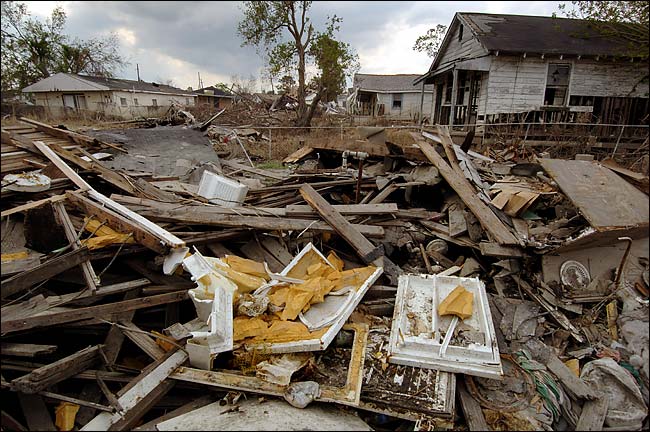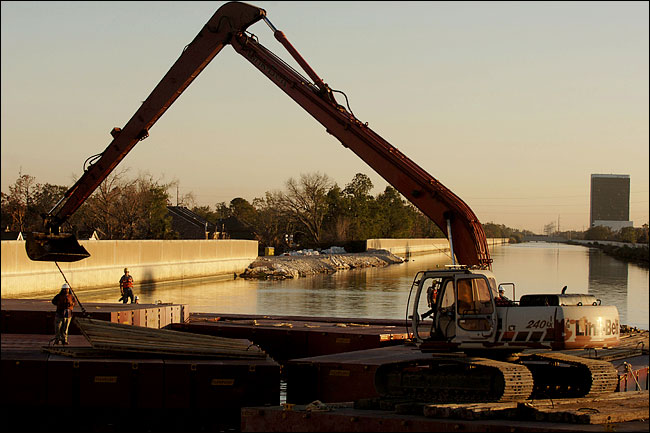

  |
|
last modified: Monday, December 19, 2005 11:08 AM |
|
Group Lending and Its Applicability to a Post-Katrina New Orleans |
|
William McElnea |
wmcelnea@umich.edu |
[This entry is the third part of a three-part entry arranged in conjunction with Samara Freemark and Elizabeth Delgado.
Part I, Group Lending: Learning From the International Experience
Part II, Group Lending in the United States]
Hurricane Katrina's Impact on the New Orleans Small Business Sector
In the aftermath of Hurricane Katrina, an estimated 57,000 New Orleans small businesses are expected to have been destroyed and/or put out of business.[1] Unemployment hit 14.8% in September 2005, and strategies to help job creation in the disaster’s wake are now hard sought after. With small business accounting for approximately 75% of all net new jobs in the United States, helping the redevelopment of this sector will be a top priority for New Orleans.
At the time of this paper’s completion, the Louisiana Recovery Authority was considering making a request for $10 billion in grants from the state of Louisiana to help small businesses, and the U.S. Congress was considering a proposal that would immediately set aside $450 million in small business loans.[2] Since the amount that will end up being allocated by state and federal government will most likely not be sufficient to comprehensively address the needs of New Orleans small business owners, there will surely be ample room for the commercial sector to try and meet the demand for start-up and reconstruction capital. Yet commercial banks may not be eager to immediately get involved in loaning to small businesses that might be in danger of defaulting should another disaster strike. Strategies to minimize this risk of default will therefore be a central part of promoting microlending by commercial entities.

The Group Lending Model’s Place in New Orleans Small Businesses Development Post-Hurricane Katrina
The city of New Orleans has historically embodied the term ‘close-knit community’. Pre- Katrina, it has been seen as one of the most socially active, colorful, and neighborhood-based cities in the United States. As the home of jazz and blues, the city’s musical history has played a large role in its socially interactive character. Its warm climate and small block communities contribute to its interactive nature as much time among citizens is spent outdoors.
New Orleans culture has also been shaped by its small “mom and pop” businesses, which both lined and spotted the city’s streets before Katrina. It could be argued that in order to salvage even a piece of New Orleans’ unique pre-Katrina, tourist friendly atmosphere, at least a portion of these mom-and-pop businesses will have to be restored. It is these businesses that face the greatest challenges in rebuilding and sustaining their businesses, especially since the future availability of start-up capital is uncertain. Fortunately, the very close-knit community culture that makes New Orleans unique could well be the feature that provides security to commercial lenders, specifically to those lenders willing to engage in group lending schemes.
We now take a look at some of the similarities between the conditions of the developing countries where group lending has been most successful and the current state of New Orleans. We then move on to offer a number of proposals for group lending strategies for the New Orleans small business sector.
Parallels Between Group Lending Communities in the Developing World and a Post-Katrina New Orleans
The devastation after Hurricane Katrina has left New Orleans in a desperate state. Tens of thousands of homes and businesses have been ruined, leaving thousands homeless and without work. Electricity and running water are still nonexistent in parts of the city. Local commerce has plummeted and with it the local economy. Crime has risen considerably. Many of the thousands of citizens that left the city will not return due to lack of job availability and/or means to rebuild their houses as many were uninsured. Serious environmental hazards are still present as a result of the massive flooding that took place. Both the city and the state, already in financial trouble before the disaster, are struggling to figure out how they will afford the reconstruction.

In many respects, New Orleans will be starting from scratch under arduous conditions with limited resources. Its predicament, in some very specific ways, can be likened to many developing nations, even Bangladesh (home to the group lending model), a country whose citizens, for the most part, lack suitable housing and sanitation facilities, employment opportunities that pay a living wage, health care or insurance, and perhaps most pertinently, physical collateral to guarantee a loan. As addressed earlier in this paper, the lack of such a collateral makes it extremely difficult to obtain credit through conventional means. Therefore, in the absence of this, Grameen Bank and others in Bangladesh decided introduce the group lending model and create what is now referred to as “social collateral”, using peer pressure and social ties to ensure loan repayment.[3] There are a number of advantages in employing this technique in present day New Orleans, where numerous small business owners have now lost what little physical collateral they had before the disaster:
1) As small business owners must start from virtually nothing now, they will inevitably require a great deal of assistance in getting back on their feet. The group lending model gives all business owners in a group the incentive to make sure their partners’ businesses are fully rebuilt and self-sustainable. If one falls behind, they all suffer as a consequence.
2) Businesses involved will form groups that they believe will make good on their loan. This reduces the banks’ cost of screening applicants and is a central part of why microfinance succeeds in the developing world.[4]
3) The need for small business owners to re-establish their businesses is urgent, both for the owner and society. This sense of urgency and the instinctual drive to generate a means to survive post-Katrina will levy significant pressure on group members in danger of loan repayment delinquency. Such pressure will inevitably help to improve repayment rates among New Orleans businesses involved in group lending.
4) New Orleans is now home to a continuous stream of immigrants from Latin America and faces significant challenges in helping these immigrants settle in a new New Orleans. The group lending model, which possesses an inherent cultural synergy with the countries from where these individuals emigrated, could serve to facilitate immigrant integration into U.S. society by offering much needed employment opportunities.
While there are a number of group lending methods New Orleans could embrace, three of the (perceivably) most feasible will be described in this paper.
One principal concern of New Orleans citizens is that a post-Katrina New Orleans will lack the unique aesthetic and personality that the pre-Katrina New Orleans possessed. New Orleans businesses played a large part in this aesthetic and therefore, careful consideration must be given to recreating these businesses to restore the city’s character. This means giving small businesses the means to rebuild on the land in which they were operating before the disaster. It also reveals an opportunity for neighborhood businesses that were successful before the hurricane to work together to attain those same levels of success now.
One strategy businesses and banks could employ would be the establishment of “group lending zones” or “block lending zones” where small businesses, in an effort to recreate what was lost in the disaster, could work together in a group lending scenario to rebuild their businesses. Businesses would work with neighboring businesses on their block and possibly others in their immediate vicinity to rebuild block or “zone” businesses and assist one another with start-up logistics. These businesses would be required to meet periodically to a) discuss progress made on loan repayment and b) share and critique each other’s financial management plans. Mechanisms developed by bank administrators could assist group lending zones in attaining maximal transparency between businesses so that group members could work together effectively to meet loan obligations.
Strategy Pros: Small business owners could start again in the neighborhoods where they are most familiar. They would know the community and more importantly, the local consumer base and the goods and services in demand in the area.
Strategy Cons: Initially, the businesses involved in the lending zones would not be familiar with the inner workings of each other’s businesses. Typically, group lending succeeds in “village-like” communities where business owners have considerable knowledge about their partners’ enterprise, even before a group loan is made. This scenario is harder to replicate in the U.S. due to the considerably larger size of U.S. small businesses.
A second strategy would entail the creation of small business mini-plazas whereby local business owners would form groups with anywhere from six to twelve businesses. This ‘business group’ would then establish a mini-plaza in an area to be decided on by the group through consensus. A loan could be given to a group looking to own both the land and the business space once it is built. Alternatively, loans could also be made for groups in need of funds to cover rental costs and who have made an agreement with the land-owner of a mini-plaza.
Certain aspects of the small business mini-plaza, such as group communication mechanisms, transparency in financial management, and collaboration on logistical start-up matters, would mimic the “group lending zone” approach. Other aspects, such as strategizing business locations within the plaza to maximize collective profits, would be unique to the mini-plaza approach.
Strategy Pros: The mini-plaza strategy would give business owners the opportunity to choose their group lending partners by perceived ability to repay, rather than by where they were located before the disaster. The close proximity in which these small businesses would then operate in the plaza would facilitate inter-business cooperation and assistance, improving chances for sustainability. Furthermore, with this approach, business owners would be able to choose those business partners that would both complement their own business and help maximize consumer traffic into their own stores.
Strategy Cons: The proliferation of mini-plazas in New Orleans could substantially detract from the original character of the city. Instead of neighborhood-based “mom and pop” business areas, a more modernist and arguably monotonous economic planning approach will be employed. Such a shift in New Orleans’ character could significantly dampen the city’s tourism prospects, though it can be argued that these prospects would be minimal in the first place given the extent of the damage.
The Neighborhood Credit Union
A third strategy would entail administering New Orleans group lending through neighborhood credit unions, a technique that has been explored in the Berkshires and elsewhere [see Samara Freemark, Innovative Strategies for Small Business Encouragement]. Under a microlending credit union model, individuals both deposit money into an interest-bearing savings account, and act as board members to make decisions about where that money is invested. Depositors are also borrowers; they submit proposals for funding to the Board, which votes to choose which project to fund. This method operates as a large lending/savings circle, capitalizing on the advantages of group lending (peer pressure to repay, and peer support).
This model has potential in New Orleans, especially if infused with government money. Specifically, state, local, or federal governments could provide seed capital (up to $100,000) to set up local credit unions in targeted neighborhoods. This money could be used as double-matched funding for aspiring entrepreneurs who could buy in to the credit union. For example, a buy-in limit could be set at $200. If fifty neighborhood entrepreneurs bought in (a total pot of $10,000), they would be eligible for $20,000 in government funding, creating a $30,000 fund for lending to small neighborhood businesses. Some of the government money would be set aside to guarantee the savings loans, just as the government guarantees normal savings accounts. The group would exercise pressure on borrowers, because additional loan money would not be available until initial loans were repaid. Also, the fact that the units would be localized to serve specific neighborhoods would provide and additional incentive for depositors to help borrowers succeed: they would be neighbors. Market interest rates would be charged; the advantage to borrowers would come in the form of expedited credit availability in a time of urgent need in New Orleans.
Strategy Pros: This method would take advantage of the benefits of group lending but may be more appropriate to the U.S. business environment. Also, it would both take advantage of the traditional community structure of New Orleans and help to enhance that structure.
Strategy Cons: The neighborhood base of the credit unions is important to the success of these kinds of ventures. However, there may not be enough entrepreneurs in individual neighborhoods to create significant demand for neighborhood credit unions.
Group lending has traditionally been perceived as a microfinance strategy
for the developing world. Since administratively it was not cost-effective
to hand out loans to poor individuals in these countries, larger loans to
groups was the efficient alternative. New Orleans is now faced with a small
business sector that will eventually grow to become what it was before: a
robust part of the economy and New Orleans culture where banks were willing
to invest on a business-by-business basis. Currently, however, there is
considerably more perceived risk in loaning to individual small businesses
than before as these businesses must now start from nothing. Under such dire
circumstances, new methods to help continue a successful U.S. culture of
credit-initiated growth must be explored while regulations that impede the
implementation of unconventional strategies should be eliminated. The group
lending model, while presenting numerous challenges in a U.S. environment,
can fill an important void in present-day New Orleans, particularly one that
wishes to use its strongest community-based features in rebuilding a uniquely
colorful and more resilient city.
Sources Consulted
Jennifer Steinhauer, “New Orleans Is Still Grappling With the Basics of Rebuilding”, New York Times, November 8, 2005.
Miram Wasserman, “Hope on Credit”, Federal Reserve Bank of Boston: Regional Review, Quarter 4, 1998. Online. Available: http://www.bos.frb.org/economic/nerr/rr1998/q4/wass98_4.htm
[1] Jennifer Steinhauer, “New Orleans Is Still Grappling With the Basics of Rebuilding”, New York Times, November 8, 2005.
[2] Jennifer Steinhauer, “New Orleans Is Still Grappling With the Basics of Rebuilding”, New York Times, November 8, 2005.
[3] Miram Wasserman, “Hope on Credit”, Federal Reserve Bank of Boston: Regional Review, Quarter 4, 1998. Online. Available: http://www.bos.frb.org/economic/nerr/rr1998/q4/wass98_4.htm
[4] Miram Wasserman, “Hope on Credit”, Federal Reserve Bank of Boston: Regional Review, Quarter 4, 1998. Online. Available: http://www.bos.frb.org/economic/nerr/rr1998/q4/wass98_4.htm